- News
- lifestyle
- health-fitness
- de-stress
- Low brows, fast thinkers: Expert decodes what eyebrow height says about your personality
Low brows, fast thinkers: Expert decodes what eyebrow height says about your personality

High arch vs soft arch: What your eyebrows say about you
This might sound a bit out there, but facial expression expert Brian Galke recently dropped a pretty interesting insight on Instagram that caught a lot of attention. He suggests that the height of your eyebrows could actually give clues about how you make decisions. Yep, your eyebrows! That little strip of hair above your eyes might be telling more about you than you realized.
So, here’s the gist: according to Galke, people with lower eyebrows tend to be fast thinkers. They process information quickly and are more likely to make snap decisions. On the flip side, those with higher eyebrows often like to take their time, mull things over, and weigh their options before coming to a conclusion. Sounds kind of wild, right? But when you think about it, it actually makes some sense.
Watch the video here

The quick decision makers: Low brows
If you’re someone with lower-set eyebrows, you might notice you’re naturally inclined to act fast. Maybe you don’t overthink too much and just go for it. Brian Galke’s explanation is that these folks have a more direct, straightforward way of approaching choices. Instead of sitting around second-guessing or asking “what if,” they dive right in.
Think about your friends or coworkers—there’s always that one person who’s ready to make a call or solve a problem immediately, no hesitation. Chances are, they might be rocking the low-brow look. It’s not just about looks; it’s a window into their mental wiring.
These quick decisions don’t mean they’re reckless or impulsive, though. It’s more like their brains are wired to synthesize info rapidly and act. It’s a strength, especially in fast-paced environments where hesitation can cost you. Quick thinkers often excel in emergencies or situations where time is of the essence.

The thoughtful deliberators: High brows
On the other side of the spectrum, people with higher eyebrows tend to be the thoughtful, slower decision-makers. They prefer to consider all angles, gather data, and really chew on the possibilities before deciding.
Maybe you’re the type who hates rushing. You want to make sure you get it right before you say yes or no. Or maybe you’re just someone who loves analyzing and loves knowing you’ve covered all your bases.
According to Galke, these higher-brow individuals might pause longer during decisions because their brain likes to weigh the pros and cons carefully. They’re not slow for no reason—they’re deliberate, cautious, and want to avoid mistakes.
Both styles have their pros and cons. Quick decision-makers can sometimes overlook details, while careful thinkers might miss opportunities because they’re still deciding. Neither is “better” — it’s all about knowing yourself and others.

It’s just a tendency, not a rule
Before you start sizing up everyone’s eyebrows at your next meeting, it’s important to remember Galke’s key point: these are general tendencies, not hard rules. Your eyebrow height won’t definitely tell you how someone thinks or acts. People are complex, and many factors shape how we make decisions—personality, experience, mood, even the situation itself.
But here’s the cool part: knowing these little facial cues can actually help improve communication. Say you’re dealing with a colleague who’s got higher eyebrows and seems slow to answer your questions. Maybe instead of pushing for an immediate decision, you give them a little breathing room to process. Or if someone has low eyebrows and tends to jump in fast, you might want to slow them down a bit for more discussion.
Using eyebrow height as a clue rather than a stereotype can make your interactions smoother and more understanding. It’s a subtle but powerful tool in reading the people around you.

The old school roots: Physiognomy
Now, the idea that facial features tell us about personality isn’t exactly new. It actually traces back to an ancient practice called physiognomy—basically, the study of facial characteristics and how they might reflect someone’s nature.
Physiognomy has been around for centuries, popping up in cultures all over the world. Back in the day, people believed things like eyebrow shape, eye size, or jawline could reveal if you were brave, honest, or clever. Sounds a bit like fortune telling, right?
Modern science, of course, is way more cautious about these claims. While it’s fun to think your eyebrows might spill your secrets, researchers warn against overgeneralizing or making snap judgments based on looks alone. After all, personality is complicated and shaped by tons of factors way beyond our face.
But physiognomy’s core idea—looking at facial expressions and features to understand people—didn’t disappear completely. It evolved into studying microexpressions and other subtle cues that really do tell us a lot about what someone’s feeling or thinking in the moment.

Eyebrows as emotional and social signals
Eyebrows, in particular, are super expressive. They move a lot, and small changes can signal surprise, confusion, anger, or happiness. So it’s not too far-fetched to think that their shape and natural position might be connected to how our brains process information or emotions.
Experts like Brian Galke are exploring how those natural resting positions relate to cognitive styles—like whether you’re a fast or slow thinker. It’s not about judging but about understanding the subtle signals people give off.
So next time you catch someone mid-conversation, take a quick peek at their brows and see if you notice anything. Maybe you’ll find new ways to understand and relate to the people around you—just from a glance at those little arches above your eyes.









